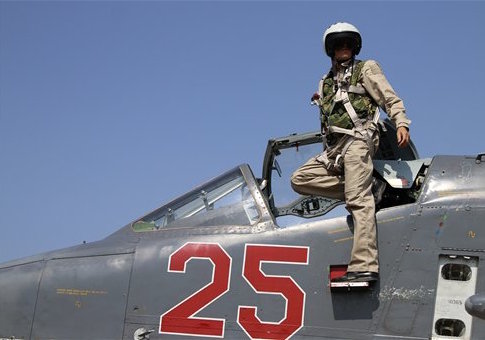Russian aircraft bombed a military outpost in Syria used by American and British special forces last month, according to a new report.
The remote garrison, located near the Jordanian border, was a secret base of operations for the two military forces, the Wall Street Journal reported Thursday.
U.S. military and intelligence officials said the previously unreported June 16 bombing and a separate Russian strike on a site associated with the Central Intelligence Agency was an attempt by Moscow to pressure the Obama administration to cooperate during air campaigns in Syria.
While no military personnel were killed in the strike, the incident drove opposition at the Pentagon and CIA to the Obama administration’s plan to coordinate military operations with Russia inside Syria. The White House ultimately moved forward with the proposal.
Secretary of State John Kerry, who reportedly shares some of the concerns of military and intelligence officials, reached an agreement with Russian leaders in Moscow last week that instructs the two military forces to coordinate joint bombing operations against Jabhat al-Nusra, al-Qaeda’s official branch in Syria.
The provisional deal mandates the U.S. military to share information with Russia about specific targets in Syria, in exchange for Moscow halting its bombing campaign against U.S.-supported rebels.
Opponents of the pact at the Pentagon and CIA said that the Obama administration caved into "Russian bullying" and that Moscow could not be trusted to honor the agreement’s provisions.
U.S. military and intelligence officials said that a contingent of about 20 British special forces had pulled out of the base 24 hours before Russian aircraft dropped cluster munitions on the garrison last month.
The Wall Street Journal reported:
After that first Russian strike, officers with the U.S. military’s Central Command air operations center in Qatar called their counterparts in Russia’s air campaign headquarters in Latakia, Syria, U.S. officials said. The American officers told the Russians that the garrison was part of the U.S. campaign against Islamic State and shouldn’t be attacked. Roughly 90 minutes after the U.S. warning was delivered, U.S. aircraft circling nearby watched as the Russians launched a second wave of strikes against the garrison. A U.S. military surveillance aircraft overhead tried to hail the Russian pilots directly using the frequencies which the U.S. and Russian governments had agreed to use in emergencies. The Russian pilots didn’t respond. U.S. officials said four rebels were killed in the Russian strikes.
U.S. military and intelligence officials rejected an initial explanation from the Russians that they thought the garrison was an ISIS facility. The Russians then said that Jordanian forces had approved of the strikes. U.S. officials said that they conferred with Amman and the Jordanian military never gave Russia the go ahead.
The U.S. shared information with the Russians about American operations near the Jordanian border and told Moscow to avoid the area.
Instead, on July 12, days before Kerry closed the deal with Moscow, Russian aircraft targeted a second base near the Jordanian border used by family members of U.S.-backed Syrian rebels.
The strike killed two young children, aged two and three, along with two young women and a man, according to a rebel commander. An additional 48 civilians were injured.
